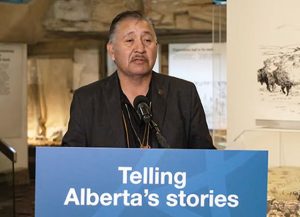‘Help us to help ourselves’: Piikani Nation chief calls for tourism site at exhibit launch

Piikani Nation Chief Troy (Bossman) Knowton speaks at the unveiling of the new Buffalo Hunt exhibit at Head-Smashed-In Buffalo Jump. Screenshot
By Somya Lohia, Local Journalism Initiative Reporter
Piikani Nation Chief Troy (Bossman) Knowlton is calling on the Alberta government and tourism bodies to support the creation of an information site near Highway 3 — a place that would showcase Piikani culture and draw travellers into Blackfoot traditional territory.
Speaking at the unveiling of a new exhibit at Head-Smashed-In Buffalo Jump on June 18, Knowlton seized the moment to deliver a direct appeal to provincial leaders and Indigenous tourism representatives in attendance.
He emphasized that while the site draws as many as 60,000 visitors annually, nearby Piikani Nation remains largely absent from the tourism map. Knowlton urged Alberta Tourism and Indigenous Tourism Alberta to work with Piikani to develop local attractions that highlight authentic Indigenous culture.
“Right across the road is Piikani. How do you get to recognize us? How do you assist us to create tourism stops, whether they can be destinations or part of the route that people could plan on?” Knowlton asked Indigenous Tourism Alberta.
He also highlighted ongoing negotiations with the Government of Alberta and Alberta Transportation regarding the twinning of Highway 3, noting that thousands of vehicles travel the highway daily.
“As part of the negotiations, I would like to see a museum, cultural interpretive centre, or something along that line that will pull people in and allow us to have a site or have an area for our crafters, our storytellers and other parts of our culture that we could share,” he said.
Knowlton directed his comments to officials present, including Tanya Fir, Alberta’s minister of arts, culture and status of women, and representatives from Indigenous Tourism Alberta.
“I am putting this to you, and I am going to tell everybody else who will listen until they are sick and tired of me saying this,” he said. “Bring that to your ministry, because I sure am.”
Knowlton also called on them to help Piikani strengthen tourism opportunities.
“We have got rodeos, we have got powwows,” he said. “There are a number of good things happening on the nation, and a lot of it we could self-fund, but I don’t think we should only self-fund. I think we ought to have partnerships that we could build that would be long-lasting,” he said.
“Help us to help ourselves. We’re not asking for a handout. We’re asking for a hand up,” he appealed.
The event marked the opening of a new Buffalo Hunt exhibit, a reimagined diorama exhibit that explores the spiritual and cultural significance of buffalo hunting — a tradition that sustained the Plains Peoples for generations.
“It’s a beautiful diorama that depicts the buffalo jump,” said Knowlton. “This entire centre has done a lot to preserve our culture and our heritage. This new addition will add to that and educate people worldwide when they come here.”
Located on the traditional territory of the Blackfoot Confederacy, Head-Smashed-In Buffalo Jump is a UNESCO World Heritage Site that preserves more than 6,000 years of Plains Buffalo culture.
During his speech, Knowlton connected personal stories of growing up fishing and hunting along the Oldman River with the deeper cultural history embedded in the land surrounding the Buffalo Jump.
He recounted finding remnants of past campsites — firepits, animal bones and boiling pits — exposed along the riverbanks during spring runoff.
“That tells the story of our existence there,” he said. “This entire river valley is full of those types of sites.”
Joining Knowlton at the launch were Minister Fir, Kainai Nation Chief Travis Plaited Hair, Livingstone-Macleod MLA Chelsea Petrovic, and Canadian Museum of History curator Tim Foran, along with elders, knowledge keepers and other dignitaries.
